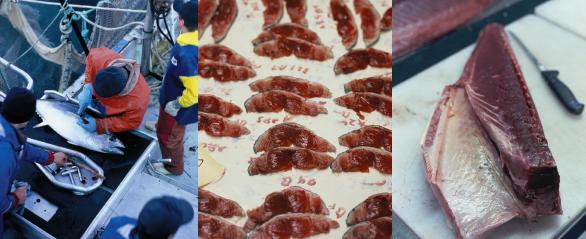
Once back on dry land, the tuna are taken to a processing plant not far from the water’s edge. Here they are gutted, thoroughly cleaned, weighed, measured, and evaluated. A sliver of meat is cut from the base of each fish’s tail and closely inspected. The Japanese market (which is where a large portion of the Stehr Group’s tuna ends up) favours a fatty meat of a deep red hue. From the cut at the base of the tail, the fat beneath the skin, as well as the intramuscular fat, can be clearly evaluated. Australian-reared tuna is more fatty than the fish grown and harvested in Japan, making the product a desirable one for the Japanese sashimi market.
The most expensive part of the tuna flesh is the belly (toro in Japanese), which has the most concentrated marbling of fat. On the current market this part of the fish will earn A$250 a kilogram.
Tuna must never be frozen if it is to retain its premium asking price, so the fish have capsules of an innocuous gel ice placed in their bellies and around their bodies. It is in this form that the fish are shipped around the country and overseas. Pallets of tuna leave Port Lincoln by road to Adelaide (some 700-plus kilometres away) or by air straight from the local airport, a few minutes out of town.
As each fish has been weighed and examined, it can be ‘identified’ and traced from this point all the way to its final destination in the markets or individual kitchens.
